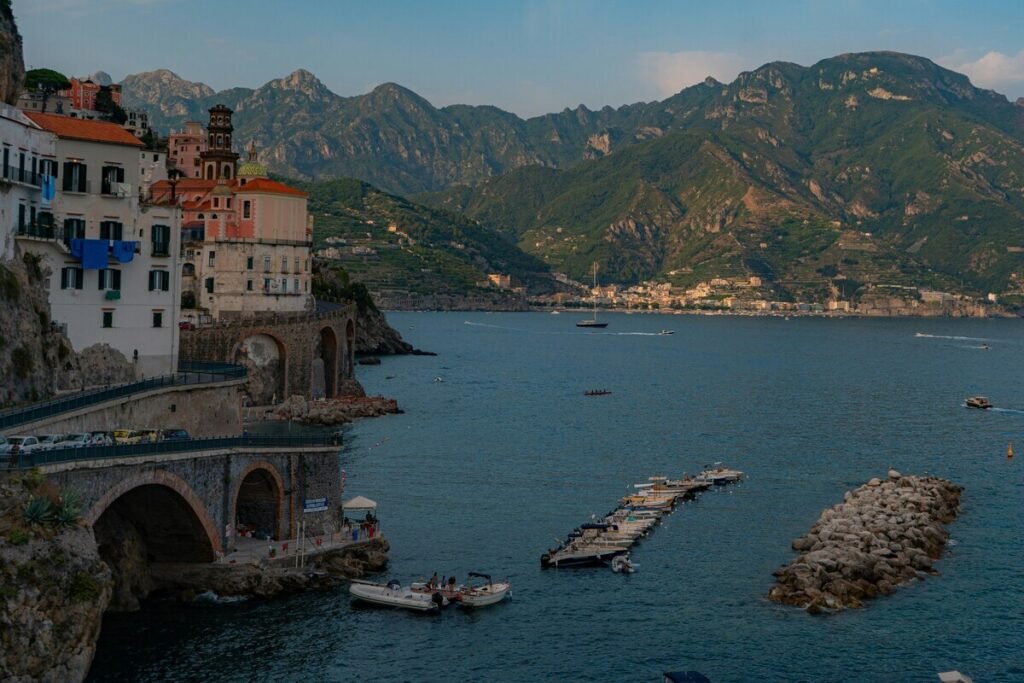Rome Travel Guide Book
Rome is one of the most known cities in the world, and this Rome travel guide book will help you make the most of your trip to the Eternal City. From top attractions and neighbourhoods to food and travel tips, we’ve got everything you need to know.
Getting to Rome
Getting to Rome is simple and convenient. With two major airports, a train station, and plenty of public transport, you’ll have no trouble arriving in the city. Explore your options in this Rome travel guide book section.
By Air
Two airports serve Rome: Fiumicino (Leonardo da Vinci) and Ciampino. Fiumicino is the main international airport. Ciampino handles budget airlines and domestic flights. Both airports offer easy access to the city centre via trains, buses, and taxis. The Leonardo Express train takes about 30 minutes and is the fastest way from Fiumicino to Roma Termini train station.
By Train
Arriving by train? You’ll likely arrive at Roma Termini, the main train station. Termini connects to other Italian cities and many European destinations. You can easily hop on the metro or bus from here or grab a taxi to your hotel.
By Bus
If you’re arriving by bus, many companies, such as FlixBus and Itabus, offer affordable and convenient connections from cities across Italy and Europe. Buses typically arrive at major terminals like Tiburtina Station or Termini Station. Both of them are well connected to the city’s public transport system.
By Car
Driving into Rome is another option, but be prepared for Rome’s busy traffic. The city’s streets can be narrow, and traffic jams are common. Finding parking can also be challenging, as spaces are limited and often expensive. For these reasons, consider using public transport. Or walking around the city once you arrive to avoid the hassle of driving and parking.
Where to Stay?
Choosing where to stay during your trip to Rome can affect your experience. In this section of the Rome travel guide book, let’s explore some of the best neighborhoods.
Centro Storico (Historic Center)
The Centro Storico is the heart of Rome. You’ll be close to landmarks like the Pantheon, Piazza Navona, and Trevi Fountain. This area is perfect for those who want to walk to major attractions but can be expensive.
Trastevere
Trastevere offers a more authentic Roman experience. Located just across the river, this area is known for its lively nightlife and cosy, narrow streets. You’ll find plenty of bars, restaurants, and hidden gems here.
Monti
Monti is a great choice if you want a mix of history and hip. It’s a trendy area close to the Colosseum and Roman Forum. Monti has a lot of boutique shops, vibrant cafés, and cool vibe.
Testaccio
Food lovers should consider staying in Testaccio. This area is less touristy and known for its markets and traditional Roman cuisine. It’s a bit off the beaten path but gives you a true taste of local life.
Top Attractions According to Rome Travel Guide Book
Rome is packed with world-famous landmarks. No Rome travel guide book would be complete without mentioning these must-see attractions.
Colosseum
The Colosseum is one of the most iconic landmarks in the world. Built nearly 2,000 years ago, this ancient arena once held 50,000 spectators. It was the stage for gladiator battles, animal hunts, and even mock sea battles.
Today, it’s a symbol of ancient Rome’s grandeur. Visitors can explore the underground chambers, where gladiators and wild animals were kept. You’ll also see the massive arches and intricate systems of vaults that allow for smooth crowd control.
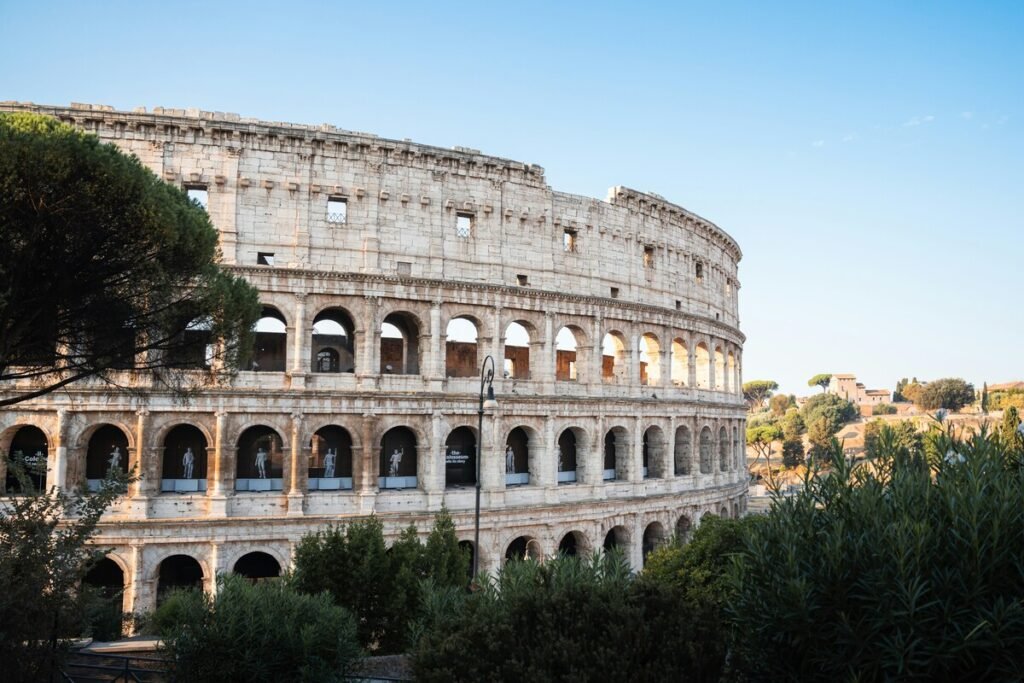
Did you know? The Colosseum is one of the New Seven Wonders of the World.
Tip: Book tickets in advance to skip the long lines. Consider a guided tour to access the hypogeum, the underground tunnels.
Roman Forum
Right next to the Colosseum lies the Roman Forum. This area was the heart of ancient Rome’s political and social life. Here, important decisions were made, and public speeches were held.
Today, the ruins of temples, basilicas, and government buildings give visitors a glimpse into the city’s past. From the Temple of Saturn to the House of the Vestal Virgins, you’ll walk through centuries of history.
Did you know? The Roman Forum was buried under centuries of debris until it was excavated in the 18th century.
Tip: Climb Palatine Hill for stunning views of the Forum and the rest of Rome. It’s also where the imperial palaces once stood.
Vatican City
Vatican City is the smallest country in the world, but it has important religious sites. The most famous is St. Peter’s Basilica, the largest church on Earth. Inside, you’ll find Michelangelo’s Pietà and Bernini’s Baldachin.
The Vatican Museums house priceless art collections, including works by Raphael, Leonardo da Vinci, and Caravaggio. The highlight for many is the Sistine Chapel, where Michelangelo’s frescoes cover the ceiling.
Did you know? St. Peter’s Basilica is built on the site where St. Peter, one of Jesus’s apostles, is believed to be buried.
Tip: Buy tickets online to avoid long lines, especially for the Vatican Museums.
If you’re planning to spend more time in the smallest country in the world, check this article about top things to see in Vatican City.

Pantheon
The Pantheon is one of the best-preserved buildings from ancient Rome. It was built as a temple to all the gods but later became a Christian church. The massive dome is a marvel of ancient engineering.
An oculus at the dome’s centre lets natural light into the building. The effect is stunning, especially when the light hits the centre at noon.
Inside, you’ll find the tombs of famous figures, like the artist Raphael and Victor Emmanuel II, Italy’s first king.
Did you know? The Pantheon’s dome is still the largest unreinforced concrete dome in the world.
Trevi Fountain
The Trevi Fountain is the largest and one of the most beautiful fountains in Rome. Designed by Nicola Salvi in 1762, it features Oceanus, the god of water, riding a chariot pulled by seahorses.
It’s famous for its legend: if you toss a coin into the fountain, you’ll be guaranteed to return to Rome. Over €3,000 is thrown into the fountain daily, and the money is donated to local charities.
Tip: Visit early in the morning or late at night to avoid crowds. The fountain is magical when lit up at night.
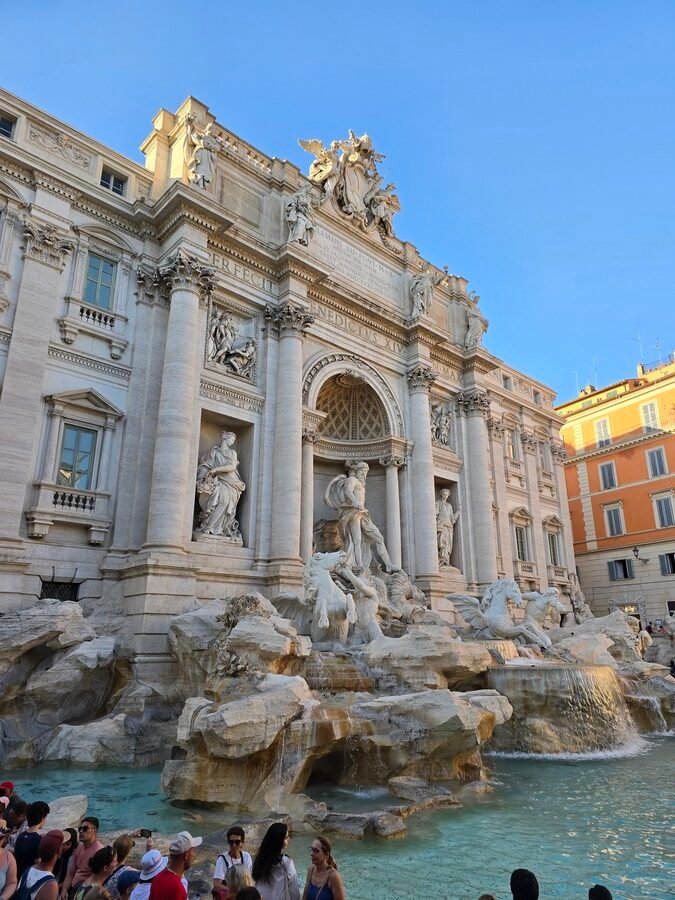
Villa Borghese
Villa Borghese is one of Rome’s largest parks and offers a peaceful escape from the busy streets. It spans nearly 200 acres and is ideal for walking, biking, or just relaxing.
The park is public and filled with gardens, fountains, and sculptures. At its centre is the Galleria Borghese, which houses masterpieces by artists like Bernini and Caravaggio.
Tip: Rent bikes or golf carts to explore the park more easily. Rental stations are located at many entrances.
Spanish Steps
The Spanish Steps are a grand staircase connecting Piazza di Spagna with the Trinità dei Monti church at the top. Built in 1725, the 135 steps are a favourite meeting spot for tourists and locals alike. At the bottom, you’ll find the Fontana della Barcaccia, a fountain shaped like a sinking boat.
Did you know? Noone can sit on these steps because it’s forbidden by law.
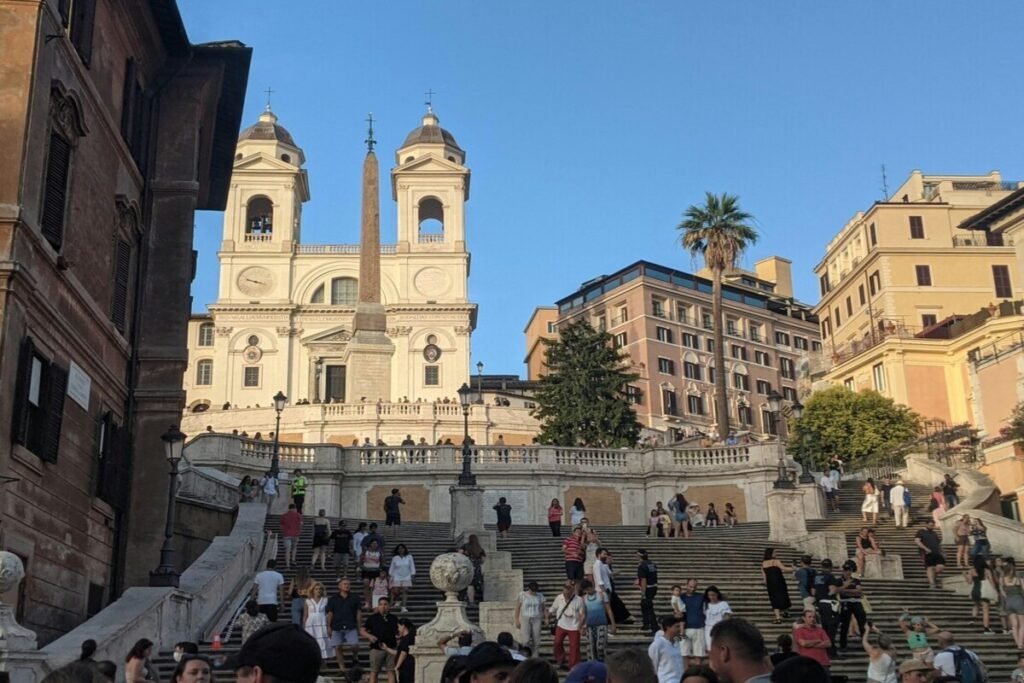
Piazza Navona
Piazza Navona is one of Rome’s most vibrant squares. It was built on the site of an ancient stadium where athletic contests were held. Today, it’s famous for Bernini’s Fountain of the Four Rivers, which represents the Nile, Ganges, Danube, and Rio de la Plata. The square is full of cafés, restaurants, and street artists, making it a great place to relax and people-watch.
Tip: Visit during the Christmas season to enjoy the festive market.
Castel Sant’Angelo
Castel Sant’Angelo was originally built as a mausoleum for Emperor Hadrian in 123 AD. Over the centuries, it has served many roles, including a fortress, papal residence, and prison. Today, it’s a museum with exhibits on its history. You can climb to the top for breathtaking views of the Tiber River and Vatican City.
Did you know? Castel Sant’Angelo is connected to the Vatican by a hidden passage used by popes in times of danger.
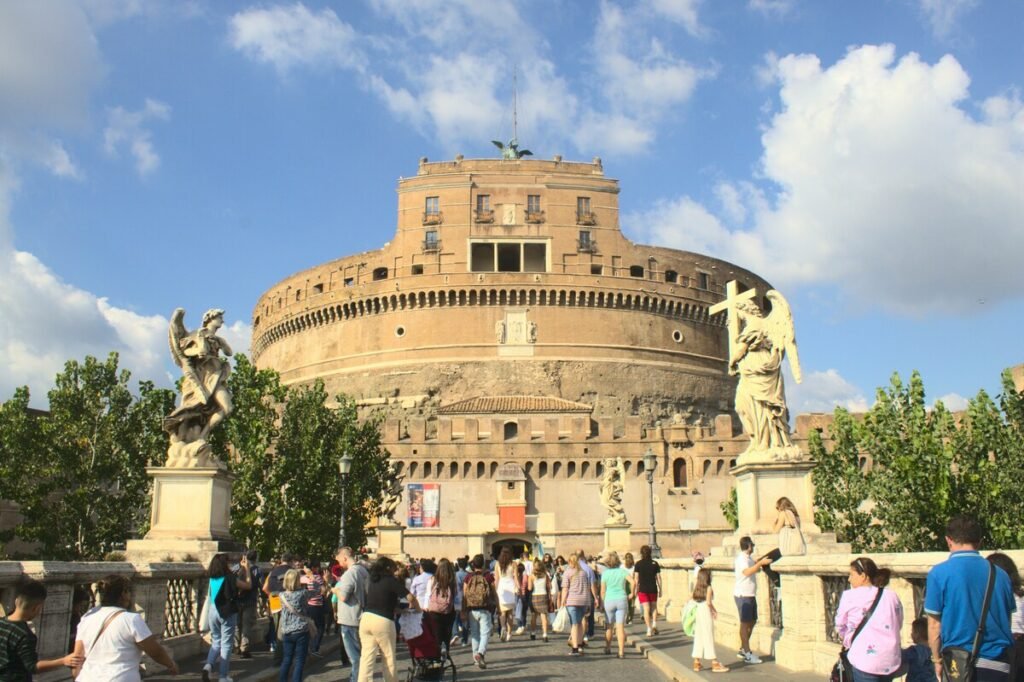
Tip: Walk across the Ponte Sant’Angelo, the beautiful bridge leading to the castle, lined with statues of angels designed by Bernini.
Food and Drinks in Rome
Rome is a city that takes its food seriously. No Rome travel guide book would be complete without diving into the local cuisine.
Must-Try Roman Dishes
Rome is famous for its pasta; you can’t leave without trying the city’s signature dishes. Pasta alla Carbonara is made with eggs, cheese, and pancetta. Cacio e Pepe is a simple yet delicious pasta made with cheese and black pepper. And don’t forget Supplì, a fried rice ball filled with cheese or meat, perfect for a quick snack.
Best Places to Eat
Rome is full of trattorias, osterias, and upscale restaurants. In Testaccio, you’ll find some of the best traditional Roman food. Try Roscioli near Campo de’ Fiori for a splurge, famous for its cheese and cured meats. If you’re in Trastevere, stop by Osteria da Enzo al 29, a cosy spot locals love.
Local Markets
Rome’s markets are the place to sample fresh produce and local products. Campo de’ Fiori has a lively market selling fruits, vegetables, and speciality foods. Mercato Testaccio is another favourite, with food stalls selling everything from pizza to pastries.
Gelato Spots
Don’t forget the gelato! Some of the best places to try include Gelateria dei Gracchi and Giolitti, one of the oldest gelato shops in Rome. Look for places where the gelato is stored in covered tubs — a sign of quality!
Rome for History Buffs
Rome is a treasure trove of history. This Rome travel guide book has already mentioned the Colosseum and Roman Forum, but history lovers can explore so much more.
Archaeological Sites
If you’re fascinated by history, be sure to visit Ostia Antica, an ancient harbour city just outside of Rome. The ruins are incredibly well-preserved, and you can explore streets, houses, and public baths that date back over 2,000 years.
Another great site is the Baths of Caracalla, one of ancient Rome’s largest public bath complexes. It’s easy to imagine life in the Roman Empire while walking through the towering ruins.
Museums and Galleries
Rome is home to some incredible museums. The Capitoline Museums house an extensive collection of Roman artefacts, while the Galleria Borghese features Caravaggio, Bernini, and Raphael masterpieces. Art and history lovers will find endless inspiration here.
Navigating Rome Like a Local
Getting around Rome is easy once you know how. This Rome travel guide book provides some useful tips for navigating the city.
Public Transportation
Rome’s public transportation includes buses, trams, and two metro lines. The metro is the fastest way to get across the city, especially if you travel between Roma Termini and major attractions like the Colosseum or the Vatican. Buses are also convenient but can be slow due to traffic. Tickets are valid on all forms of public transport and must be purchased in advance from newsstands or machines.
Walking in Rome
One of the best ways to explore Rome is on foot. The city’s historic centre is compact, and walking allows you to discover hidden gems you might miss on a bus or metro. Wear comfortable shoes, as many streets are cobblestone.
Biking and Scooters
Consider renting a bike or scooter if you want to cover more ground. Rome has several bike rental shops and scooter-sharing services. Just be cautious — traffic in Rome can be chaotic, so it’s important to stay alert.
Budgeting Your Trip According to Rome Travel Guide Book
Rome can be expensive, but there are plenty of ways to save money. This section of the Rome travel guide book offers tips for travelling on a budget.
Free Things to Do
Many of Rome’s most famous sights, such as the Trevi Fountain and Villa Borghese, are free to visit. You can also visit St. Peter’s Basilica for free, though climbing the dome is a charge. State museums and archaeological sites offer free entry on the first Sunday of each month.
Check out this article to find 12 free things to do in Rome.
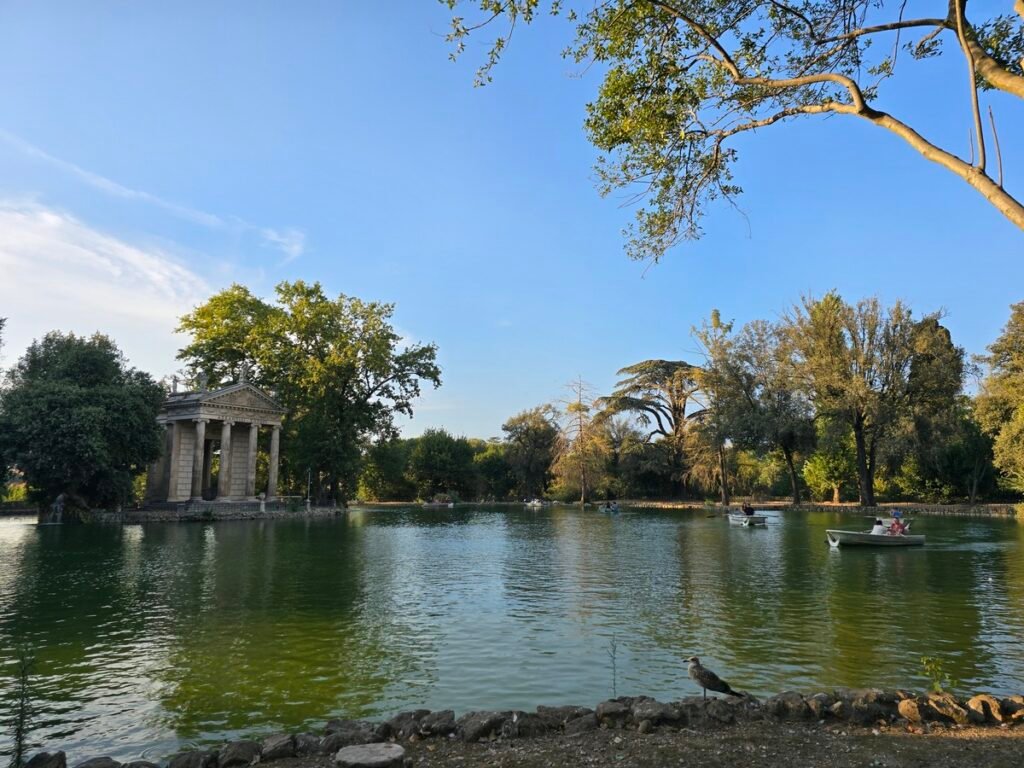
Dining on a Budget
Eating well in Rome doesn’t have to cost a fortune. Look for local trattorias and osterias, where you can enjoy a delicious meal at a fraction of the price of more touristy restaurants. Also, don’t underestimate the power of street food — pizza al taglio (pizza by the slice) and supplì are great options for a cheap, tasty meal.
Affordable Accommodations
If you’re travelling on a budget, consider staying in a hostel or budget hotel. Rome has plenty of options that offer clean, comfortable accommodations without breaking the bank. Another option is to look for vacation rentals, which can be a more affordable choice, especially for longer stays.
Rome at Night
Rome transforms after sunset. The city’s monuments are beautifully lit, giving them a different feel from the daytime. No Rome travel guide book is complete without advice on how to experience Rome’s magical nights.
Nighttime Walking Tours
Many of Rome’s top attractions, like the Colosseum and Trevi Fountain, look stunning under the lights. An evening walk tour can be a memorable way to see these landmarks without the daytime crowds.
Best Spots for an Evening Aperitivo
An aperitivo is a must when in Rome. It’s a tradition to have a pre-dinner drink, often accompanied by small bites. The lively neighbourhood of Trastevere is a great place for an evening aperitivo. Another excellent spot is Monti, known for its hip vibe and trendy wine bars. Both areas are ideal for sitting outdoors, enjoying the atmosphere with a glass of Italian wine or a cocktail.
Wine Bars and Speakeasies
If you’re looking for unique nightlife, Rome also has several excellent wine bars and speakeasies. Freni e Frizioni in Trastevere is a favourite for its laid-back atmosphere and large outdoor seating area. Try Jerry Thomas Speakeasy, one of the city’s most famous hidden bars, for something more secretive and stylish. You’ll need a password to get in, but once inside, you’ll experience a 1920s-style bar serving creative cocktails.
Tip: Rome’s nightlife tends to start later. Bars and clubs don’t get busy until 10 p.m., so plan accordingly.
Day Trips from Rome Travel Guide Book
Rome is surrounded by beautiful towns and landscapes that make for perfect day trips from Rome. This section of the Rome travel guide book will cover some top destinations.
Tivoli
Located just outside of Rome, Tivoli is home to two incredible UNESCO World Heritage sites: Villa d’Este and Hadrian’s Villa. Villa d’Este is famous for its beautiful gardens and fountains, while Hadrian’s Villa is the ruins of a massive Roman palace complex.
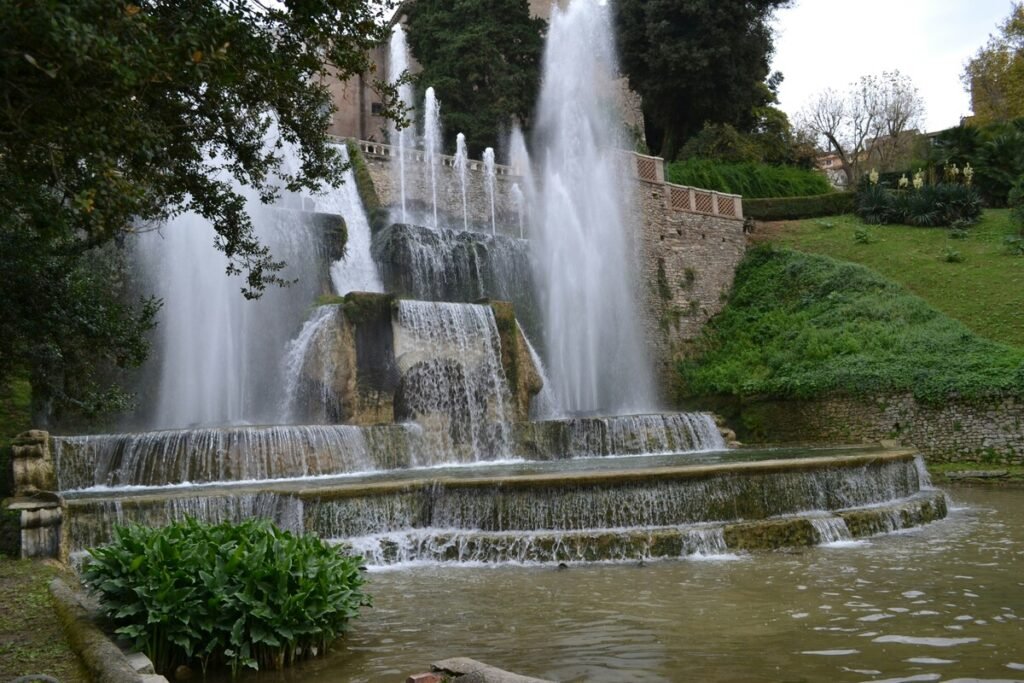
Ostia Antica
As mentioned earlier, Ostia Antica is an ancient Roman harbour town perfect for history lovers. It’s easy to reach by train from Rome and offers a more peaceful alternative to the crowded city centre.
Orvieto
If you’re looking for a charming hilltop town, Orvieto is a great choice. This medieval town is known for its stunning cathedral and underground caves. It’s also a great place to sample Umbrian wine and food.
Castelli Romani
The Castelli Romani region is known for its rolling hills and picturesque towns. Frascati is one of the most famous for its white wine and charming streets. It’s a great place to relax and enjoy the beauty of the Italian countryside.
Amalfi Coast
An Amalfi day trip from Rome is the perfect short getaway. This coastline is a UNESCO World Heritage site. It spans over 50 kilometres along the southern Tyrrhenian Sea and is home to 13 charming towns. The coast has rugged cliffs, pristine waters, and colourful villages.
Practical Travelling Tips According to Rome Travel Guide Book
Navigating Rome can be overwhelming, especially for first-time visitors. Having some practical tips will make your trip smoother and more enjoyable. From safety advice to must-have apps, knowing how to prepare is essential. That is why you will find all the necessary tips and advice in this Rome travel guide book. So explore with confidence and make the most of your visit.
Safety Tips in Rome
One of the most common issues tourists face is pickpocketing, especially in crowded areas or on public transport. Keep your belongings close, use anti-theft bags, and avoid keeping valuables in your back pocket. Be extra cautious on the metro, particularly around Termini Station.
Another scam to watch out for is overpriced restaurants in tourist-heavy areas. Some places near major landmarks charge far more than what’s reasonable. Always check the menu and prices before sitting down. Look for authentic restaurants in neighbourhoods like Trastevere or Testaccio, which are known for local cuisine and fair prices.
Be aware of fake tour guides around popular sites like the Vatican and Colosseum. Stick to official tours or services with good online reviews. Licensed guides in Rome usually wear badges with their photo, name, and license number.
Seasonal Travel Advice
Rome is a year-round destination, but the experience changes with the seasons. Knowing when to visit can help you plan the perfect trip.
Spring (April-May) and Fall (September-October)
Spring and fall are considered the best times to visit Rome. The mild weather makes it ideal for walking around and exploring the city. Plus, the crowds are smaller than in the peak summer months.
Summer (June-August)
Summer in Rome can be hot, with temperatures often exceeding 30°C (86°F). The city also sees more tourists during this time. However, summer offers special events like Lungo il Tevere, a festival along the Tiber River with street food, live music, and pop-up bars.
Winter (December-February)
Winter is the quietest time of year for tourism in Rome, making it perfect for those who prefer fewer crowds. The weather can be chilly, but the city is beautifully decorated for Christmas, and you can visit Christmas markets throughout the city. January 6 marks the Epiphany celebrations, with events and parades, especially around Piazza Navona.
Tip: No matter when you visit, booking tickets for major attractions in advance is a good idea.
Public Holidays and Festivals in Rome
Public holidays and festivals can affect your travel plans, so it’s important to know what’s going on during your visit.
La Befana (Epiphany) on January 6
This is a big holiday in Italy, celebrating the Epiphany with parades and sweets. Piazza Navona hosts a lively market, and children receive gifts from La Befana, a witch-like figure in Italian folklore.
Ferragosto (August 15) Ferragosto
It is one of Italy’s most important holidays. Many Romans leave the city for vacation, and some shops and restaurants close during this time. However, Rome can feel quieter and more relaxed, making exploring easier without the usual hustle and bustle.
Rome’s Birthday (April 21)
Rome celebrates its founding on April 21 every year. Known as Natale di Roma, this day features parades, historical reenactments, and fireworks. It’s a great time to experience the celebrations in the city.
Tip: Be sure to check what’s open and plan your visits to major attractions around these holidays.
Health and Medical Services in Rome
While no one plans to get sick on vacation, it’s important for any Rome travel guide book to include practical information on healthcare.
Pharmacies (Farmacie)
Pharmacies in Rome are easy to find, and many are open 24 hours. Look for a green cross sign to locate them. Pharmacists can provide basic medications and advice for common ailments.
How to Call Emergency Services?
In case of an emergency, you can dial 112, the European emergency number. It will connect you to the appropriate services, including the police, ambulance, or fire department.
Travel Insurance
Having travel insurance is highly recommended for non-EU tourists. It can cover medical expenses and give you peace of mind during your trip. If you do need medical care, public hospitals are available, and there are also private clinics for non-emergencies.
Tip: Always keep a copy of your travel insurance policy and emergency contact numbers with you.
Useful Apps for Navigating Rome
MyTaxi or Uber
Getting around Rome is simple with apps like MyTaxi (now Free Now) or Uber. Both services allow you to order a taxi or ride-share from your phone. Uber operates in limited areas, so taxis are often more reliable.
Rome2Rio or Moovit
For public transportation, Rome2Rio and Moovit are great options. They provide real-time routes and schedules for buses, trams, and the metro, helping you easily navigate the city.
TheFork
Use TheFork to make reservations at some of Rome’s best dining restaurants. It also includes reviews and deals that can help you find a great meal without the hassle.
Google Maps
It is essential for walking directions. You can even download maps for offline use, making it easy to navigate Rome’s winding streets without using data.
Tip: Download these apps before your trip to save time and avoid connectivity issues.
Cultural Etiquette and Practical Tips
Local Customs
Italians are known for their friendliness, but some customs must be kept in mind. Always greet people with a polite “buongiorno” (good morning) or “buonasera” (good evening). When dining, waiting for everyone’s meal to arrive before you start eating is polite. Tipping is appreciated but not always expected — rounding up the bill or leaving a small amount is usually enough.
Language Tips
While many people in Rome speak English, italians always appreciate if you try to speak some basic Italian. Learn a few key phrases like “grazie” (thank you), “per favore” (please), and “scusi” (excuse me).
Rome is a city that never fails to enchant its visitors. With this Rome travel guide book, you will now explore the Eternal City like a pro. Whether you’re marvelling at ancient ruins, enjoying a plate of carbonara, or strolling through picturesque streets, Rome will leave a lasting impression.
To make the most of your time in Rome, plan ahead but also leave room for spontaneous discoveries. Follow this guide, but don’t be afraid to wander off the beaten path and find your own Roman adventure.
And don’t forget — toss a coin into the Trevi Fountain to ensure you’ll return to Rome one day. Because after your first visit, you’ll definitely want to come back.


